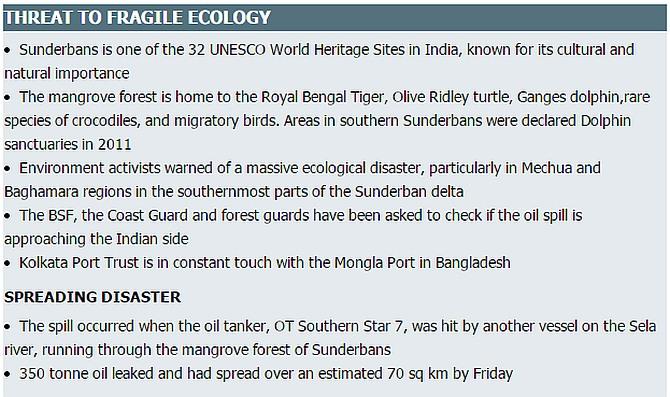 An ecological disaster is in the making in the Sunderbans, the world’s largest mangrove forest spanning across the Indo-Bangla border, after an oil tanker collided with an empty cargo vessel. The incident spilled nearly 350 tonnes of oil into the Sela river, threatening the survival of multiple species of flora and fauna.
An ecological disaster is in the making in the Sunderbans, the world’s largest mangrove forest spanning across the Indo-Bangla border, after an oil tanker collided with an empty cargo vessel. The incident spilled nearly 350 tonnes of oil into the Sela river, threatening the survival of multiple species of flora and fauna.
The collision sent Indian official agencies, including the West Bengal forest department, Border Security Force (BSF) and the Coast Guard, into a tizzy on speculation that the spillage might cross over to the Indian side of the forest.
The Sunderbans is one of the 32 UNESCO World Heritage Sites in India, known for its cultural and natural importance. The forest is home to the Royal Bengal Tiger, Olive Ridley turtle, Ganges dolphin and several migratory birds from Siberia, apart from rare species of crocodiles.
The tanker was reportedly on way to deliver the oil to a power plant in Gopalganj when struck by the other vessel on Tuesday in a sanctuary for dolphins, including the rare Irrawaddy species. The spill from the oil tanker, named OT Southern Star 7, had spread over an estimated 70 sq km by Friday.
The accident left at least 20 canals connected with the Sela river, apart from a major river, Pashur, affected even as the sunk tanker was salvaged on Thursday. The Bangladesh government has lodged a case against the owners of the two vessels and sent four navy ships to deal with the spill.
Environment activists warned of a massive ecological disaster due to the spill, particularly in the Smechua and Baghamara regions in the southernmost parts of the Sunderban delta, where individual rivers meet the sea. Local officials said a close tab is being kept on the areas likely

“There is no report of Indian side getting affected and chances seem remote so far. However, field staff, particularly those deployed in the camps along the Indo-Bangla border, has been alerted,” West Bengal’s Principal Chief Conservator of Forest (Wildlife) Ujjwal Kumar Bhattacharya said. “Patrolling has been beefed up to check if the oil spill is spreading to the Indian Sunderbans.”
Officials said the BSF and Coast Guard have been asked to check if the spill is approaching the Indian border. As part of the effort, Kolkata Port Trust (KoPT) is maintaining constant communication with the Mongla Port in Bangladesh. Patrolling is being intensified in the Harinbhanga river and Raimangal, which forms the boundary between Indian Sunderbans and Bangladesh’s,” a KoPT official said.
Areas in the southern Sunderbans were declared dolphin sanctuaries in 2011 after research showed nearly some 6,000 Irrawaddy dolphins lived there. The accident where the crash took place is a no-go zone for vessels. Environmentalists state that the brackish water shipping route through the Sunderbans is in violation of ecological norms.
According to the standards of Oil Industry Safety Directorate under the Indian petroleum ministry, an oil spill of less than 700 tonne is considered Tier-I, the lowest of the three tiers of threat to safety. Oil spills are not uncommon in India. An Oil and Natural Gas Corporation (ONGC) pipeline had ruptured near Bhadbhut in Gujarat leading to oil spill in coastal areas of Gulf of Khambhat last year. Another ONGC pipeline had leaked in Gujarat in 2010 leading to a spill that later caused a fire.













 © 2025
© 2025